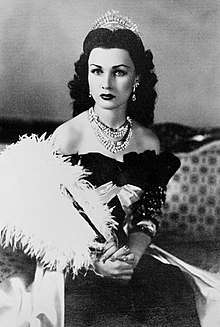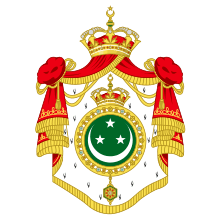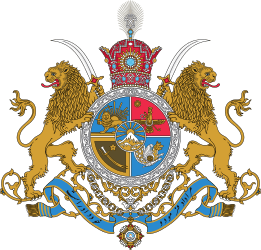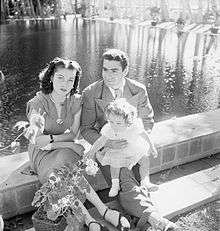Fawzia Fuad of Egypt
| Fawzia Fuad | |||||
|---|---|---|---|---|---|
 | |||||
| Queen consort of Iran | |||||
| Tenure | 16 September 1941 – 17 November 1948 | ||||
| Born |
5 November 1921 Ras el-Tin Palace, Alexandria, Sultanate of Egypt | ||||
| Died |
2 July 2013 (aged 91) Alexandria, Egypt | ||||
| Burial |
3 July 2013 Cairo, Egypt | ||||
| Spouse |
| ||||
| Issue |
Princess Shahnaz of Iran Nadia Chirine Hussein Chirine | ||||
| |||||
| House |
Muhammad Ali (by birth) Pahlavi (by marriage) | ||||
| Father | Fuad I of Egypt | ||||
| Mother | Nazli Sabri | ||||
| Religion | Islam | ||||
| Styles of Princess Fawzia of Egypt and Iran | |
|---|---|
  | |
| Reference style | Her Imperial & Royal Highness |
| Spoken style | Your Imperial & Royal Highness |
| Alternative style | Ma'am |
Fawzia Fuad of Egypt (Arabic: الأميرة فوزية فؤاد; Persian: شاهدخت فوزیه فؤاد; 5 November 1921 – 2 July 2013), also known as Muluk Fawzia of Iran, was an Egyptian princess who became Queen of Iran as the first wife of Mohammad Reza Pahlavi.
Princess Fawzia was the daughter of Fuad I, the seventh son of Ismail the Magnificent. She descended from the Muhammad Ali Dynasty.[1][2] She was also known as Fawzia Chirine (or Shirin), having married to Colonel Ismail Chirine, Egyptian diplomat of Circassian origin, in 1949. After the Egyptian Revolution of 1952, her royal titles were no longer recognized by the Egyptian government. Until her death in 2013, she was the oldest member of the deposed Muhammad Ali Dynasty residing in Egypt. Her nephew, Fuad, who was proclaimed King Fuad II of Egypt and Sudan after the Revolution, resides in Switzerland.
Life
Early life and education
Princess Fawzia was born Her Sultanic Highness Princess Fawzia bint Fuad at Ras el-Tin Palace, Alexandria, the eldest daughter of Sultan Fuad I of Egypt and Sudan (later King Fuad I), and his second wife, Nazli Sabri on 5 November 1921.[3] Princess Fawzia Fuad was of Albanian, Turkish, French and Circassian descent.[4] Princess Fawzia's maternal great-grandfather was Major-General Muhammad Sharif Pasha who is of Turkish origin is Prime Minister and Minister for Foreign Affairs.[5] One of her great-great-grandfathers was Suleiman Pasha, a French army officer who served under Napoleon, converted to Islam, and oversaw an overhaul of the Egyptian army.
In addition to her sisters, Faiza, Faika and Fathia, and her brother, Farouk,[6] she had two half-siblings from her father's previous marriage to Princess Shwikar Khanum Effendi. Princess Fawzia was educated in Switzerland[3] and was fluent in English and French in addition to her native Arabic.[7]
Her beauty was often compared to that of film stars Hedy Lamarr and Vivien Leigh.[8]
Queen of Iran
The marriage of Princess Fawzia to Iran's Crown Prince Mohammad Reza Pahlavi was planned by the latter's father, Rezā Shāh.[9][10] A declassified CIA report in May 1972 described the union as a political move.[11] The marriage was also significant in that it united a Sunni royal, the Princess, and a Shia royal, the Crown Prince.[12] The Pahlavis were a parvenu house as Reza Khan, the son of a peasant who entered the Iranian Army as a private, rising up to become a general, had seized power in a 1921 coup, and he was most anxious have the House of Pahlavi married to the House of Ali, who had reigned over Egypt since 1805.[13] The Egyptians were not impressed with the gifts sent by Reza Khan to King Farouk as to persuade him to marry his sister to Mohammad Reza, and when an Iranian delegation arrived in Cairo to arrange the marriage, the Egyptians took the Iranians on a tour of the palaces built by Isma'il Pasha, known as "Isma'il the Magnificent", to show them proper royal splendor.[14]
Princess Fawzia of Egypt and Mohammad Reza Pahlavi were engaged in May 1938.[15][16] However, they saw each other only once before their wedding.[17] They married at the Abdeen Palace in Cairo on 15 March 1939.[12][18] King Farouk took the couple on a tour of Egypt, showing them the Pyramids, Al-Azhr University, and other famous sites in Egypt.[19] The contrast between the Crown Prince Mohammad Reza, dressed in a simple uniform of an Iranian officer vs. the lavish opulence of the Egyptian court, with the famously free-spending Farouk was much remarked upon at the time.[20] When they returned to Iran the wedding ceremony was repeated at Marble Palace, Tehran, which was also their future residence.[7][17] As Mohammad Reza spoke no Turkish (one of the languages of the Egyptian elite, the other being French) and Fawzia spoke no Persian, the two talked to each in French, which both were fluent in. Upon arriving in Tehran, Reza Khan had the main streets of Tehran decorated with banners and arches, and had a celebration at the Amjadiye stadium attended by 25, 000 of the Iranian elite with synchronized acrobatics by students being followed by bastani (Iranian calisthenics), fencing, and football.[21] The wedding dinner was a French-style dinner with "caviar from the Caspian Sea", "Consommé Royal", fish, fowl and lamb.[22]
Following the marriage, the Princess was granted Iranian nationality.[23] Two years later the crown prince succeeded his exiled father and was to become the Shah of Iran. Soon after her husband’s ascent to the throne, Queen Fawzia appeared on the cover of the 21 September 1942, issue of Life magazine, photographed by Cecil Beaton, who described her as an "Asian Venus" with "a perfect heart-shaped face and strangely pale but piercing blue eyes."[18] She led the newly founded Association for the Protection of Pregnant Women and Children (APPWC) in Iran.[24]
With Mohammad Reza Shah Pahlavi she had one child, a daughter:[25]
- HIH Princess Shahnaz Pahlavi (born 27 October 1940).[26]
The marriage was not a success. Fawzia was deeply unhappy in Iran, and often missed Egypt.[27] Fawzia's relations with her mother-in-law and her sisters-in-law were notably tempestuous as the Queen Mother and her daughters saw her as a rival for Mohammad Reza's affections, and the women constantly feuded with each other.[28] One of Mohammad Reza's sisters broke a vase over Fawzia's head.[29] The womanizing Mohammad Reza was frequently unfaithful to Fawzia, and was often seen driving around with other women in Tehran from 1940 onward.[30] Popular rumor had it that Fawzia for her part had an affair with her minder, described as an athletic, handsome man, through her friends insist that this was merely malicious gossip.[31] Fawzia's son-in-law, Ardeshir Zahedi told the Iranian-American historian Abbas Milani in a 2009 interview about the rumors: "She is a lady and never veered from the path of purity and fidelity".[32]
Queen Fawzia (the title of empress was not yet used in Iran at that time) moved to Cairo in May 1945[33] and obtained an Egyptian divorce. The reason for her return was that she viewed Tehran as underdeveloped in contrast to modern, cosmopolitan Cairo.[34][35] She consulted an American psychiatrist in Baghdad for her troubles shortly before she left Tehran.[33] On the other hand, CIA reports claim that Princess Fawzia ridiculed and humiliated the Shah due to his supposed impotence, leading to their separation.[35] In her book Ashraf Pahlavi, twin sister of the Shah, argues that it was the Princess not the Shah who asked for divorce.[17] Fawzia left Iran for Egypt, and despite numerous attempts on the part of the Shah to persuade her to return, she remained put in Cairo.[36] Mohammad Reza told the British ambassador in 1945 that his mother was "probably the main obstacle to the return of the Queen".[37]
This divorce was first not recognized for several years by Iran, but eventually an official divorce was obtained in Iran, on 17 November 1948, with Queen Fawzia successfully reclaiming her previous distinction of Princess of Egypt as well. A major condition of the divorce was that her daughter be left behind to be raised in Iran.[38] Incidentally, Queen Fawzia’s brother, King Farouk, also divorced his first wife, Queen Farida, in November 1948.[38][39]
In the official announcement of the divorce, it was stated that "the Persian climate had endangered the health of Empress Fawzia, and that thus it was agreed that the Egyptian King’s sister be divorced." In another official statement, the Shah said that the dissolution of the marriage "cannot affect by any means the existing friendly relations between Egypt and Iran."[40] After her divorce Princess Fawzia headed the Egyptian court.[34]
Later life

On 28 March 1949, at the Koubba Palace in Cairo, Princess Fawzia married Colonel Ismail Chirine (or Shirin) (1919–1994), who was the eldest son of Hussein Chirine Bey and his wife, HH Princess Amina Bihruz Khanum Effendi.[41][42] He was a graduate of Trinity College, Cambridge and a one-time Egyptian minister of war and the navy. Following the wedding they lived in an estate owned by the Princess in Maadi, Cairo.[42][43] They also resided in a villa in Smouha, Alexandria.[44]
They had two children, one daughter and one son:[45]
- Nadia Chirine (19 December 1950, Cairo[46] – October 2009). She married first (and divorced) Yusuf Shabaan, an Egyptian actor,[44] and second with Mustafa Rashid. She had two daughters, one with her first husband, and another with her second husband:
- Sinai Shabaan (born October 1973)[44]
- Fawzia Rashid
- Hussein Chirine (born 1955, Giza)
Fawzia lived in Egypt after the 1952 Revolution that toppled King Farouk.[47] Princess Fawzia's death was mistakenly reported in January 2005. Journalists had confused her with her niece, Princess Fawzia Farouk (1940–2005), one of the three daughters of King Farouk. In her later life, Princess Fawzia lived in Alexandria, Egypt, where she died on 2 July 2013 at the age of 91.[3][48] Her funeral ceremony was held after noon prayers at Sayeda Nafisa Mosque in Cairo on 3 July.[49] She was buried in Cairo next to her second husband.[18]
Gallery
 Queen Fawzia with Shah Mohammad Reza Pahlevi and their daughter, Princess Shahnaz in Tehran during the Second World War.
Queen Fawzia with Shah Mohammad Reza Pahlevi and their daughter, Princess Shahnaz in Tehran during the Second World War. The wedding ceremony of Princess Fawzia and Mohammad Reza Pahlavi. From left to right: King Farouk of Egypt (the bride's brother), Princess Fawzia (the bride) and the Crown Prince of Iran (the groom).
The wedding ceremony of Princess Fawzia and Mohammad Reza Pahlavi. From left to right: King Farouk of Egypt (the bride's brother), Princess Fawzia (the bride) and the Crown Prince of Iran (the groom).- Commemoration Medallion of Marriage of Mohammad Reza Shah Pahlavi and Princess Fawzia of Egypt – March 1939 – The medallion is now in Sahebgharanie palace in Niavaran Palace complex.
Legacy
A town in Iran, Fawziabad, was named for Princess Fawzia in 1939.[7] A street in Maadi, Cairo, was again named for her in 1950 as Amira Fawzia street, but in 1956 it was renamed as Mustafa Kamel street.[50]
Honours
.svg.png)

Ancestry
| Ancestors of Fawzia Fuad of Egypt | ||||||||||||||||||||||||||||||||||||||||||||||||||||||||||||||||||||||||||||||||||||||||||||||||||||||||||||||||||||||||||||||||||||||||||||||||||||||||||||||||||||||||||||||||||||||||||||||||||||||||||||||||||||||||||||||||||||||||||||||||||||||||||||||||||||||||||||||||||||||||||||||||||||||||||||||||||||||||||||||||||||||||||||||||||||||||||||||||||||||||||||||||||||||||||||||||||||||||||||||||||||||||||||||||||||||||||||||||||||||||||||||||||||||||||||||||||||||||||||||||||||||||||||||||||||||||||||||||||||||||||||||||||||||||||||||||||||||||||||||||||||||||||||||||||||||||||||||||
|---|---|---|---|---|---|---|---|---|---|---|---|---|---|---|---|---|---|---|---|---|---|---|---|---|---|---|---|---|---|---|---|---|---|---|---|---|---|---|---|---|---|---|---|---|---|---|---|---|---|---|---|---|---|---|---|---|---|---|---|---|---|---|---|---|---|---|---|---|---|---|---|---|---|---|---|---|---|---|---|---|---|---|---|---|---|---|---|---|---|---|---|---|---|---|---|---|---|---|---|---|---|---|---|---|---|---|---|---|---|---|---|---|---|---|---|---|---|---|---|---|---|---|---|---|---|---|---|---|---|---|---|---|---|---|---|---|---|---|---|---|---|---|---|---|---|---|---|---|---|---|---|---|---|---|---|---|---|---|---|---|---|---|---|---|---|---|---|---|---|---|---|---|---|---|---|---|---|---|---|---|---|---|---|---|---|---|---|---|---|---|---|---|---|---|---|---|---|---|---|---|---|---|---|---|---|---|---|---|---|---|---|---|---|---|---|---|---|---|---|---|---|---|---|---|---|---|---|---|---|---|---|---|---|---|---|---|---|---|---|---|---|---|---|---|---|---|---|---|---|---|---|---|---|---|---|---|---|---|---|---|---|---|---|---|---|---|---|---|---|---|---|---|---|---|---|---|---|---|---|---|---|---|---|---|---|---|---|---|---|---|---|---|---|---|---|---|---|---|---|---|---|---|---|---|---|---|---|---|---|---|---|---|---|---|---|---|---|---|---|---|---|---|---|---|---|---|---|---|---|---|---|---|---|---|---|---|---|---|---|---|---|---|---|---|---|---|---|---|---|---|---|---|---|---|---|---|---|---|---|---|---|---|---|---|---|---|---|---|---|---|---|---|---|---|---|---|---|---|---|---|---|---|---|---|---|---|---|---|---|---|---|---|---|---|---|---|---|---|---|---|---|---|---|---|---|---|---|---|---|---|---|---|---|---|---|---|---|---|---|---|---|---|---|---|---|---|---|---|---|---|---|---|---|---|---|---|---|---|---|---|---|---|---|---|---|---|---|---|---|---|---|---|---|---|---|---|---|---|---|---|---|---|---|---|---|---|---|---|---|---|---|---|---|---|---|---|---|---|---|---|---|---|---|---|---|---|---|---|---|---|---|---|---|---|---|---|---|---|---|---|---|---|---|---|---|---|---|---|---|---|---|---|---|---|---|---|---|---|---|---|---|---|---|---|---|---|---|---|---|---|---|---|---|---|---|---|---|---|---|---|---|---|---|---|---|---|---|---|---|---|---|---|---|---|---|---|---|---|---|---|---|---|---|---|---|---|---|---|---|---|---|---|---|---|---|---|---|---|---|---|---|---|---|---|---|---|---|---|---|---|---|---|
| ||||||||||||||||||||||||||||||||||||||||||||||||||||||||||||||||||||||||||||||||||||||||||||||||||||||||||||||||||||||||||||||||||||||||||||||||||||||||||||||||||||||||||||||||||||||||||||||||||||||||||||||||||||||||||||||||||||||||||||||||||||||||||||||||||||||||||||||||||||||||||||||||||||||||||||||||||||||||||||||||||||||||||||||||||||||||||||||||||||||||||||||||||||||||||||||||||||||||||||||||||||||||||||||||||||||||||||||||||||||||||||||||||||||||||||||||||||||||||||||||||||||||||||||||||||||||||||||||||||||||||||||||||||||||||||||||||||||||||||||||||||||||||||||||||||||||||||||||
References
- ↑ In the house of Muhammad Ali: a family album, 1805–1952 By Hassan Hassan
- ↑ "Tale of 1001 Royal Egyptian Nights, Princess Fawzia of Egypt once Queen of Iran". Travel in style. Archived from the original on 30 November 2012. Retrieved 6 November 2012.
- 1 2 3 "Princess Fawzia Fuad of Egypt". The Telegraph. 5 July 2013. Retrieved 16 July 2013.
- ↑ Montgomery-Massingberd, Hugh, ed. (1980). "The French Ancestry of King Farouk of Egypt". Burke's Royal Families of the World. Volume II: Africa & the Middle East. London: Burke's Peerage. p. 287. ISBN 978-0-85011-029-6. OCLC 18496936.
- ↑ Goldschmidt, Arthur (2000). Biographical dictionary of modern Egypt. Lynne Rienner Publishers. p. 191. ISBN 1-55587-229-8.
- ↑ "Nazli". A Bit of History. Retrieved 15 August 2013.
- 1 2 3 "Colorful Fetes Mark Royal Wedding that will Link Egypt and Persian". The Meriden Daily Journal. 13 March 1939. Retrieved 8 August 2013.
- ↑ Hansen, Suzy (21 December 2013). "Queen Fawzia". The New York Times Magazine. New York: Arthur Ochs Sulzberger Jr. Retrieved 7 December 2016.
- ↑ Camron Michael Amin (1 December 2002). The Making of the Modern Iranian Woman: Gender, State Policy, and Popular Culture, 1865-1946. University Press of Florida. p. 137. ISBN 978-0-8130-3126-2. Retrieved 3 July 2013.
- ↑ "The Pahlavi Dynasty". Royal Ark. Retrieved 23 July 2013.
- ↑ "Centers of Power in Iran" (PDF). CIA. May 1972. Retrieved 5 August 2013.
- 1 2 "Princess Fawzia of Egypt Married". The Meriden Daily Journal. Cairo. AP. 15 March 1939. Retrieved 16 July 2013.
- ↑ Miliani, Abbas The Shah, London: Macmillan 2011 p. 62-63.
- ↑ Miliani, Abbas The Shah, London: Macmillan 2011 p. 63.
- ↑ Charmody, Diedre (27 July 1973). "Nixon forth to see Shah". The Leader Post. New York. Retrieved 10 November 2012.
- ↑ Rizk, Yunan Labib (2–8 March 2006). "Royal mix". Al Ahram Weekly (784). Archived from the original on 25 June 2013. Retrieved 16 July 2013.
- 1 2 3 "Earlier Marriages Ended In Divorce. Deposed Shah of Iran". The Leader Post. AP. 29 July 1980. Retrieved 16 July 2013.
- 1 2 3 Ghazal, Rym (8 July 2013). "A forgotten Egyptian Princess remembered". The National. Retrieved 16 July 2013.
- ↑ Miliani, Abbas The Shah, London: Macmillan 2011 p. 64.
- ↑ Miliani, Abbas The Shah, London: Macmillan 2011 p. 64.
- ↑ Miliani, Abbas The Shah, London: Macmillan 2011 p. 64-65.
- ↑ Miliani, Abbas The Shah, London: Macmillan 2011 p. 65.
- ↑ Kashani-Sabet, Firoozeh (2011). Conceiving Citizens: Women and the Politics of Motherhood in Iran. New York: Oxford University Press. p. 71. – via Questia (subscription required)
- ↑ Kashani-Sabet, Firoozeh (2011). Conceiving Citizens: Women and the Politics of Motherhood in Iran. New York: Oxford University Press. p. 113. – via Questia (subscription required)
- ↑ Dagres, Holly (4 February 2013). "When they were friends: Egypt and Iran". Ahram Online. Retrieved 4 February 2013.
- ↑ Jeffrey Lee (1 April 2000). Crown of Venus. Universe. p. 51. ISBN 978-0-595-09140-9. Retrieved 3 July 2013.
- ↑ Miliani, Abbas The Shah, London: Macmillan 2011 p. 90.
- ↑ Miliani, Abbas The Shah, London: Macmillan 2011 p. 78.
- ↑ Miliani, Abbas The Shah, London: Macmillan 2011 p. 139.
- ↑ Miliani, Abbas The Shah, London: Macmillan 2011 p. 78.
- ↑ Miliani, Abbas The Shah, London: Macmillan 2011 p. 139.
- ↑ Miliani, Abbas The Shah, London: Macmillan 2011 p. 139.
- 1 2 "Iran and its playboy king". The Milwaukee Journal. Time Magazine. 9 January 1946. Retrieved 23 July 2013.
- 1 2 Steyn, Mark (5 July 2013). "The Princess and the Brotherhood". National Review Online. Retrieved 16 July 2013.
- 1 2 Anderson, Jack; Les Whitten (11 July 1975). "CIA: Shah of Iran a dangerous ally". St. Petersburg Times. Washington. Retrieved 16 July 2013.
- ↑ Miliani, Abbas The Shah, London: Macmillan 2011 p. 138.
- ↑ Miliani, Abbas The Shah, London: Macmillan 2011 p. 138.
- 1 2 "Queens Lack Male Heirs, Lose Mates". Pittsburgh Post Gazette. Cairo. AP. 19 November 1948. Retrieved 16 July 2013.
- ↑ Bernard Reich (1 January 1990). Political Leaders of the Contemporary Middle East and North Africa: A Biographical Dictionary. Greenwood Publishing Group. p. 188. ISBN 978-0-313-26213-5. Retrieved 16 July 2013.
- ↑ "2 Moslem Rulers let the man and wife divorce if they need to", The New York Times, 20 November 1948, page 1.
- ↑ "Princess Fawzia engaged". The Indian Expree. 28 March 1949. Retrieved 4 February 2013.
- 1 2 "Princess Fawzia weds diplomat". Meriden Record. 29 March 1949. Retrieved 16 July 2013.
- ↑ "Maadi's Ottomans". Egy. Retrieved 17 July 2013.
- 1 2 3 Sami, Soheir (4–10 June 1998). "Profile: Youssef Shaaban". Al Ahram Weekly (380). Archived from the original on 22 December 2012. Retrieved 17 July 2013.
- ↑ "Shah's ex-wives keep low profiles in Egypt, Europe". The Palm Beach Post. AP. 28 July 1980. Retrieved 6 November 2012.
- ↑ "Girl is born to Princess Fawzia". Pittsburgh Post Gazette. Cairo. AP. 20 December 1950. Retrieved 5 February 2013.
- ↑ "Shah's first wife Princess Fawzia dies in Egypt". Dawn. 3 July 2013. Retrieved 3 July 2013.
- ↑ "Princess Fawzia, Shah's first wife, dies in Egypt". Reuters.
- ↑ "Death of Princess Fawzia". Alroeya News. 2 July 2013. Retrieved 17 July 2013.
- ↑ "Maadi Street Names". Egy. Retrieved 9 August 2013.
External links
| Wikimedia Commons has media related to Princess Fawzia Fuad of Egypt. |
- Her funeral by Yqeen News on YouTube
- Egyptian Royalty by Ahmed S. Kamel, Hassan Kamel Kelisli-Morali, Georges Soliman and Magda Malek.
- L'Egypte D'Antan... Egypt in Bygone Days by Max Karkegi.
- Chirine Family tree
Fawzia Fuad of Egypt Born: 5 November 1921 Died: 2 July 2013 | ||
| Iranian royalty | ||
|---|---|---|
| Preceded by Tadj ol-Molouk |
Queen consort of Iran 1941–1948 |
Vacant Title next held by Soraya Esfandiary-Bakhtiari |